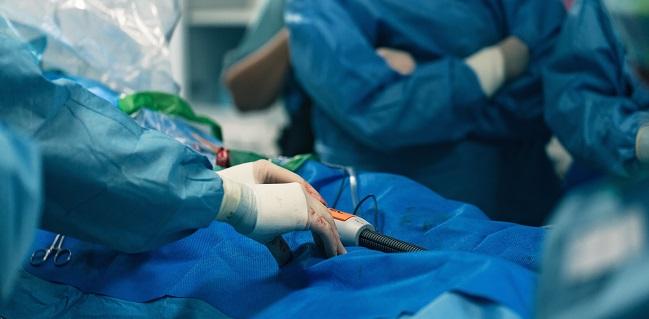EVAR—but Not Surgical AAA Repair—Is Riskier Long-term for Women
In observational data, elective EVAR in women led to higher 10-year mortality, but why women fare worse than men is unclear.

That women fare worse than men after treatment for abdominal aortic aneurysm isn’t news, but 10 years’ worth of US registry data show that the difference is long-lasting and appears restricted to endovascular repair (EVAR). In contrast, a decade after surgery, men and women are equally apt to survive.
This long-term disadvantage for women receiving EVAR “is remarkable in the fact that that’s really become the mainstay of repair these days,” investigator Bjoern D. Suckow, MD (Dartmouth-Hitchcock Medical Center, Lebanon, NH), a vascular surgeon, told TCTMD.
Growth in EVAR is increasing for both men and women, and while men are still more likely to receive the less-invasive approach, the gap is narrowing, Suckow reported. So there doesn’t seem to be a sex discrepancy in what treatment providers are choosing, but rather the imbalance in outcomes appears to stem from biological differences, he said.
“Physicians should recognize that the optimal, evidence-based strategy for AAA treatment to maximize postoperative survival may be sex specific and explore new techniques and devices to extend the benefits of endovascular treatment to women,” Suckow along with lead author Niveditta Ramkumar, MPH (The Dartmouth Institute for Health Policy & Clinical Practice), and colleagues write in their paper published recently in JAMA Network Open.
Anatomic Differences?
Using data from the Vascular Quality Initiative and Medicare claims, the researchers identified 16,386 patients aged 65 or older who underwent AAA repair between January 1, 2003, and September 30, 2015. Among them, 77.9% were men and 22.1% were women.
The female patients tended to be older, were more likely to be smokers, and overall had smaller aneurysms.
A higher proportion of women versus men received surgical repair (27% vs 18%; P < 0.001), a disparity that remained after adjustment (Risk Ratio 1.65; 95% CI 1.51-1.80). Compared with men, women had higher 10-year mortality after EVAR (adjusted HR 1.13; 95% CI 1.03-1.24) but not after surgery (adjusted HR 0.94; 95% CI 0.84-1.06). This sex difference in risk among EVAR-treated patients was only seen in elective procedures.
“The rupture group is such a small subgroup of this entire cohort that I would almost put that aside,” Suckow cautioned. What’s more interesting, he said, is the question of why in elective procedures, where operators have the time to choose between EVAR and surgery, there is a difference.
Prior studies have hinted that, overall, long-term survival with EVAR may not be as good as with surgery, Suckow said. It appears there are subgroups of people who don’t respond well to EVAR, either that their aneurysms don’t shrink or they continue to grow, with the consequence of higher mortality rates. Women may be more likely to fall into those subgroups, said Suckow.
In female patients, AAAs “tend to be smaller, more angled. Women are probably shorter in their older age than men, which is why you get these angles. The spine compresses as we age; arteries don’t compress, they only harden. So as our backs compress, the artery right in front of it—the aorta—gets bent or bowed,” he explained. This may make it harder to fit standard EVAR devices into female patients, Suckow suggested.
But there could be more complicated biological differences, he continued.
One poorly understood area is where inflammation fits into the AAA disease process, and Suckow proposed that the aneurysms of women may, for unknown reasons, generally be more inflamed and therefore more likely to grow post-EVAR, and to carry worse outcomes.
“Most [EVAR] devices that exist now haven’t changed much over the last 20 years. They’ve gotten better but the underlying concept is the same—it’s a self-expanding metal framework that has outward radial force and is covered in fabric so as to prevent blood from flowing through it. That outward expansion, that continued outward radial force and pressure, certainly inflames the artery it touches,” Suckow said. “We have seen over time that those arteries continue to expand. By that I mean that every neck of an aneurysm into which you put an endograft will always become the size of that endograft years later. It will stretch and expand to that—that can’t be healthy for the artery. It can’t be a noninflammatory state.”
Newer EVAR devices with better flexibility and other ways to seal blood flow may help lower that inflammatory response and improve outcomes for both sexes, Suckow said.
With surgery, by contrast, “we’ve cut out and removed the aneurysm. [So] the biology is no longer an issue, and there’s no difference between men and women,” he noted.
Caitlin E. Cox is News Editor of TCTMD and Associate Director, Editorial Content at the Cardiovascular Research Foundation. She produces the…
Read Full BioSources
Ramkumar N, Suckow BD, Arya S, et al. Association of sex with repair type and long-term mortality in adults with abdominal aortic aneurysm. JAMA Network Open. 2020;3(2):e1921240.
Disclosures
- Ramkumar reports receiving grants from the American Heart Association and the Food and Drug Administration during the conduct of the study.
- Suckow reports no relevant conflicts of interest.


Comments